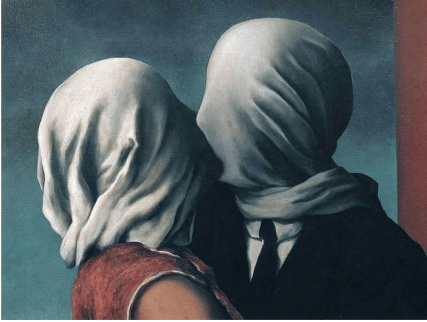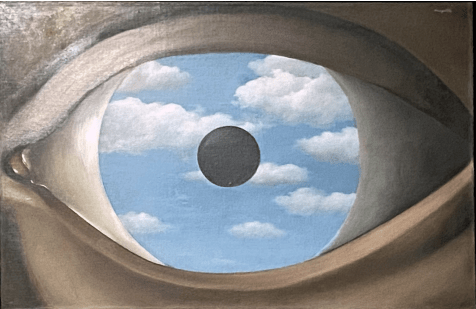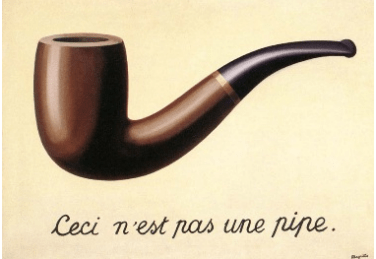Elaine Chen, On René Magritte
Sophomore year of high school was just not my cup of tea. I did not have the creative roots for graphic design and my mind definitely favored traditional manners. Yet all my peers loved to play with symbols and the abstract world. Even my art teacher gave projects on related art movements and artists. Lately, another museum visit assignment emerged, here we go again…
The first four floors of MoMA were no surprise, some art I do not understand, even after reading the labels. Well, of course, Campbell’s Soup Cans and Drowning Girl did capture my attention, those pieces are iconic pop art. Oh, and Jackson Pollock. We finally arrive on the 5th floor, the elevator opens into a room full of Picasso. It was a great tour around, yet I took a turn and something captured my eye. The Persistence of Memory lured me into a collection of “Surrealist Objects”. Walking through, I see Max Ernst, Joan Miró, and Frida Kahlo, all fascinating art styles. But then there are René Magritte’s paintings hanging, meticulous painting techniques on subjects that provoke characteristics of unordinary.
Clouds, pipes, bowler hats, and green apples. René Magritte was a Belgian surrealist artist born in 1898, specifically known for his “distractive” role in the Surrealist art movement during the 20th century. His initial paintings, dating from 1915, followed impressionism, futurism, and cubism styles. Around 1925, Magritte opened his path to surrealism after witnessing The Song of Love by Giorgio de Chirico, a new vision of unsettledness created by the strange juxtaposition of objects.1 He displayed his first surrealist oil painting in his hometown, Brussels, in 1927. Unluckily, the heap of criticism depressed Magritte and fanned his journey to Paris, joining Andre Breton and a group of French surrealists to dive into a completely perplexing portal of the surrealism movement.
To this day, The Son of Man remains René Magritte’s most famous painting, but I’ll leave that for another time. Although, I do want to know what the man with his bowler hat looks like behind the hovering green apple. We always want to see what is unseen, like a game between “the visible that is hidden and the visible that is present”.2 René Magritte plays with this theme of intrigue in The Lovers, a series of works where the subjects share intimate contact, but their faces are obscured. When Magritte was only thirteen years of age, his mother’s body was found in the

René Magritte, The Lovers II, Paris 1928, Museum of Modern Art
river, her nightdress peacefully wrapped around her head. People say Magritte was the first witness and thus this trauma inspired enshrouded faces as a common motif in his works, but no one certainly knows the true story.3 The Lovers II gives me a sense of suffocation, the hidden expressions toss me around. Bliss? The colors don’t seem to show that. Frustration or Sorrow? I can’t easily assume based on angsty red and inky blue. Do the whitish and greyish veils mean purity? I try to think profoundly but the associations of color keep provoking my thinking cycle down a different direction, this so-called preconditioned perception of reality. Magritte rarely explained his motivations behind his works, since he recalls, “mystery means nothing either, it is unknowable”.4 The False Mirror, as MoMA describes is “a huge isolated eye stares out at the

René Magritte, The False Mirror, Paris 1929, Museum of Modern Art
viewer” The iris is rather peaceful, puffy white clouds in the sky, and then there’s a pitch-black pupil in the middle, glaring deeply into my soul. This combination of calmness and uncanny is rather conflicting. Then it hits me, why is the blue expanse of the sky not presented as mirrored in the spherical, like how you look at your reflection in the spoon? So am I the observer or the observed? 5 Just like how he depicted in his work The Treachery of Images, “This is not a pipe”, the pipe is only a representation, not one that can smoke. Words don’t mean what they mean, same with images. In the end, everything René Magritte is trying to convey is merely pictured.6

René Magritte, The Treachery of Images, Paris 1929, Los Angeles County Museum of Art René Magritte’s paintings make me question my communication with people and the world. I mean, I acknowledge how everything that exists is real, but the assembly of objects or the play of appearances can jumble the psychological and evoke my unconscious mind. I never really thought of how Sigmund Freud could relate to the depiction of art. Do I understand the world I see and hear now? Not at all. I am even more confused after this whole surrealist trip. But maybe next time I spot something, I’ll reconsider the scene. I actually love the debatable idea of Traditional v.s. Conceptual art now. I guess life is just this way, it has no shape or pattern. I can’t depict or capture it. And art is just so, one day you find something out of your everyday objects and create a peculiar blast.
1“Magic Realism: Giorgio De Chirico” Matteson Art,
www.mattesonart.com/magic-realism-giorgio-de-chirico-.aspx.
2“The Son of Man.” The Son of Man by Rene Magritte, 2019, www.rene-magritte.com/son-of-man/.
3 Stanska, Zuzanna. “René Magritte: Lovers in Separation – Love Story.” DailyArtMagazine.com – Art History Stories, 29 Mar. 2020, www.dailyartmagazine.com/rene-magritte-lovers-in-separation/.
4 “Rene Magritte and His Paintings.” Rene Magritte: 100 Famous Paintings Analysis, Complete Works, & Bio, www.renemagritte.org/.
5“René Magritte. the False Mirror. Paris 1929: MoMA.” The Museum of Modern Art, 2019, www.moma.org/collection/works/78938?artist_id=3692&page=1&sov_referrer=artist.
6 Selvin, Claire. “What Do RENÉ Magritte’s Dreamlike Paintings Mean? Five Curators Offer Their Analyses.” ARTnews.com, ARTnews.com, 29 June 2020,
www.artnews.com/art-news/artists/rene-magritte-best-paintings-1202692906/.